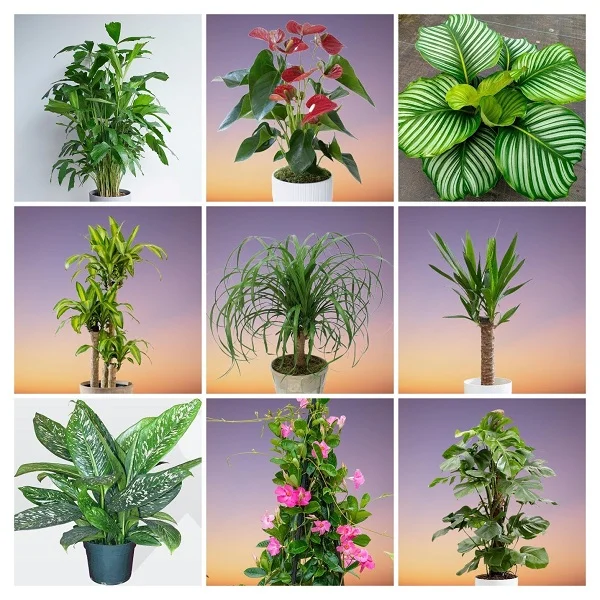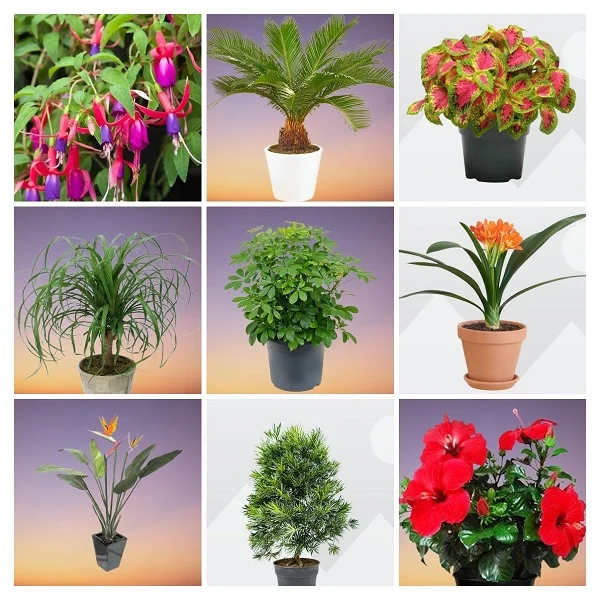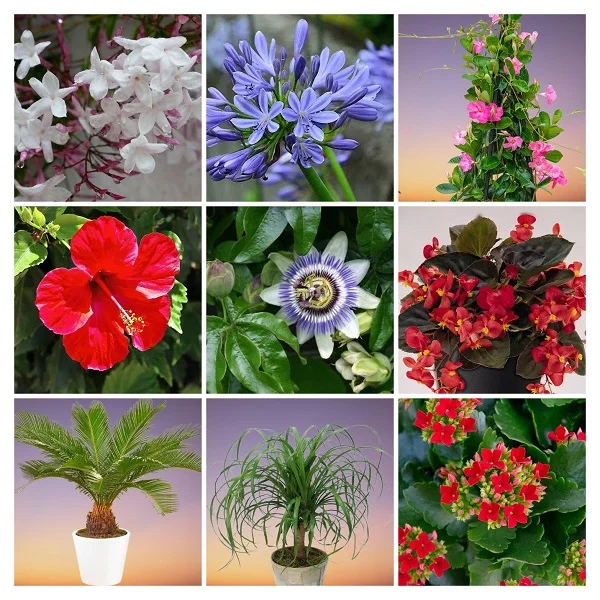Traveller's Palm (Ravenala madagascariensis) Care, Propagation, Growing Problems and Fixes
Some links in this post may be affiliate links
Traveller's Palm (Ravenala madagascariensis) prefers bright light with 6-8 hours of direct sunshine, average warmth, humid conditions and consistently moist, rich, well-drained soil coupled with monthly feeding in the growing season.
This guide will cover everything you need to know about caring for Traveller’s Palm indoors and outdoors, including watering, lighting, soil requirements, and propagation techniques. First, lets delve into some facts about this plant.
Ravenala madagascariensis also called Traveller's Tree is a palm-like plant which bears paddle-shaped leaves on long petioles, arranged in a fan-shape in a single plane.
The fan comprises of about 30-45 leaves. Each fan is about 10 feet long and about 2-3 feet wide. With age, it progressively loses the lower leaves and reveals a sturdy gray trunk. It is among the large-leafed plants for a bold statement.
The Traveller's Palm has sheaths on the stems hold rainwater which could be an emergency source of water for needy traveller's, hence, the common name, 'Traveller's Palm'.
Though called a palm, Ravenala madagascariensis, is not a true palm. It belongs to the family, Strelitziaceae. The genus name, 'Ravenala', comes from 'ravinala' or 'ravina ala' in Malagasy which means, 'forest leaves'.
Traveller's Tree can grow outdoors in warm climates and is ideal for USDA Zones 10 to 11. In the cold regions, it is grown in containers which can be brought indoors during the winter season.
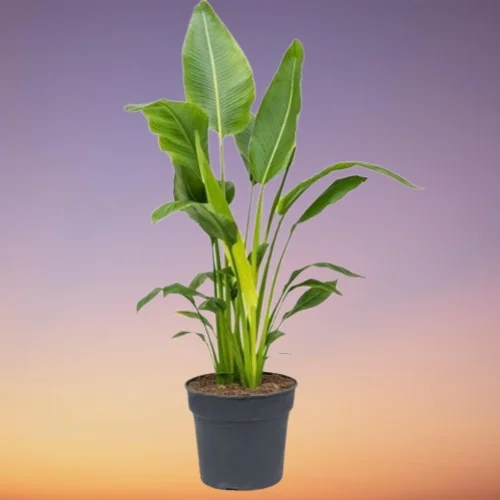
Botanical name: Ravenala madagascariensis
Family: Strelitziaceae
Common names: Traveller's Palm, Traveller's Tree, East-West Palm
Origin
Ravenala madagascariensis is native Madagascar where it is found growing in humid lowland forests, montane forests, grassland or rocky areas 1500 metres above sea level.
Size
Outdoors, Traveller's Palm can grow to a height of 30-50 feet. Indoors, it grows to a height of 8-10 feet. When young it grows fast, therefore, it requires a large space for growth but as it matures is grows much slower. It is among the popular tree-like plants for the large spaces.
Flower
The inflorescence comprises of green bracts and white flower which are less attractive than those on Bird of Paradise. The flowers appear in summer, on maturity, after about 10 years. Once pollinated, brilliant blue seeds are formed. Traveller's Tree is one of the best flowering plants for the indoors.
Varieties
Ravenala madagascariensis is the only species in this genus which comes in 4 forms (subspecies); Bemavo which is the most common, Hiranirana, Malama and Hororona which is the smallest.
Is Traveller's Palm toxic to pets?
Traveller's Palm is toxic to humans and pets. If ingested, it can cause digestive upset and other side effects. Keep the plant away from children and pets.
Related Plants
Ravenala madagascariensis is related to Strelitzia reginae (Bird of Paradise Plant) with vivid bright orange and blue flowers, and Strelitzia nicolai (White Bird of Paradise Plant) which bears large, paddle-shaped, grey-green leaves arranged in a fan-like shape.
Traveller's Palm benefits
- Tropical appeal: It adds a dramatic and exotic touch to any space.
- Fast growth: It can grow up to 10 feet in just a few years.
- Drought-tolerant: Once established it can survive short dry periods.
- Attracts wildlife: Outdoors, it supplies nectar for birds and pollinators.
Where to Buy
If you would like to add this elegant plant to your collection, Traveller's Palm seeds are available online on Etsy (Link to Etsy).
Ravenala madagascariensis Care Indoors
Traveller's Palm (Ravenala madagascariensis) grows best in bright light with 6-8 hours of direct sunshine, average warmth of 18-290C, humidity of 60-70% and consistently moist, fertile, well-drained, all purpose potting soil coupled with monthly feeding during the growing season.
Traveller's Tree requires repotting every 2 years when pot-bound. Pruning is needed to keep the plant neat, to discourage pest and disease infestations and improve ventilation. Keep on reading for more on these growing conditions and how to achieve them.
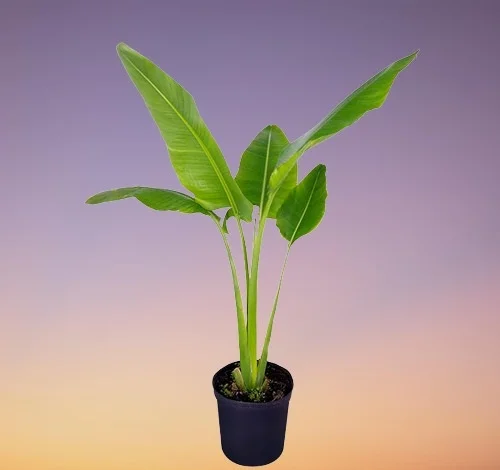
Light Requirements
Traveller's Palm grows best under bright light with at least 6-8 hours of direct sunshine. If the plant does not get adequate light, it will grow slowly and the leaves may become leggy and weak. Therefore, place the plant next to a very bright window or a brightly lit place.
Where the natural light is not adequate, consider investing in a grow light to supplement it. Rotate the pot regularly to ensure that the plant receives light on all sides for uniform growth.
Outdoors, Traveller's Tree can be grown under direct sunlight but it needs to be protected from too hot sunshine. Do not expose the plant to direct sunlight before acclimating it as it can lead to sunburn marks (brown leaf spots). It is one of the best sun-loving plants for a sunny spot.
Water Requirements
Water Traveller's Palm deeply during the growing season while allowing the top 1-2 inches of soil to dry out between waterings. Keep the soil moist but not soggy to avoid yellow leaves and root-rot.
Cut down watering in the cold season to maintain the soil slightly moist as growth is minimal at this time. Do not allow the soil to dry out completely as it can result in wilting and drooping.
Use water that is at room temperature to avoid shocking this tropical plant. Ensure that the water is chlorine-free as the plant is sensitive to chlorine and other chemicals dissolved in water and it responds with brown speckled leaf marks.
Confirm that the pot has a drainage hole to prevent the soil from getting soggy as it can lead to root-rot which is indicated by brown and yellow leaves.
Temperature and Humidity
Traveller's Palm prefers an average warmth of 18-290C with a minimum of 130C. Keep it away from drafts like air vents, radiators, heaters, windy doors and windows among others.
Traveller's Palm requires a humidity of 60-70% to thrive. Set the pot on a wet pebble tray or use a cool mist humidifier to increase humidity as low humidity will result in brown, crispy leaf tips and edges.
Occasionally, clean the leaves by damp-wiping with a soft cloth to get rid of dust to ensure adequate surface area for light absorption and also minimize pests infestation.
Potting Soil
The best soil for Traveller's Palm should be acidic, rich in organic matter and free-draining to prevent it from getting soggy while providing the required nutrients. Most all purpose potting mixes are ideal this plant.
Fertilizer
Feed Ravenala madagascariensis with a nitrogen-rich, water-soluble fertilizer monthly during the growing season to promote growth. Do not feed it the cold season as growth is minimal at this time therefore the plant does not need it. Excess feeding can result in brown leaves.
Flush out accumulated salts (which may have arisen from the water or fertilizers) regularly from the soil by running for a few minutes a steady stream of water through the soil until it comes out through the drainage holes. Repeat the process several times.
Repotting
Repot the young Traveller's Palms at the beginning of the growing season in a pot one size larger than the current one to provide adequate space for growth.
The mature trees require repotting every 2 years as the plant prefers to be root-bound into a pot 1-2 sizes larger than the current one. Use a heavy pot to prevent the plant from toppling over as it can become top heavy.
Make sure that the pot has a drainage hole and that the soil is free-draining soil to prevent it from getting soggy as it can lead to root-rot. Check out these pots with drainage holes on Amazon.
Traveller's Palm Outdoor Care
Traveller's Tree can be grown outdoors in the warm climates and is ideal for USDA Zones 10-11 where there is no threat of frost, though it can tolerate upto 00C for a short period without much damage.
Grow Traveller's Palm in full sun to light shade. However, protect the plant from harsh hot sunshine to prevent scorching (brown leaf spots).
Where the summers are very hot, grow Traveller's Tree in a shaded spot or in containers which can be easily moved to a shaded area when the sun is too hot.
Plant the Traveller's Palm in a sheltered place away from strong winds as they cause the leaves to be torn and ragged.
Ensure that the soil is well-drained and rich in organic matter. Avoid heavy clay soils as they retain too much water which can lead to root-rot and death of the plant.
Keep the soil moist through out the growing season while allowing the top 1-2 in. of soil to dry out between waterings for optimum growth but avoid soggy soil. Cut down on watering during the cold season as growth is reduced at this time.
Fertilize Traveller's Palm with a nitrogen-rich, water-soluble fertilizer monthly during the growing season.
Withhold fertilizer during the cold season as growth is reduced at this time and excess fertilizer can lead to brown leaves.
Space Traveller's Tree 6-8 feet apart as it is a large plant. Keep it 8-10 feet away from buildings as the roots are invasive.
Pruning
Pruning Traveller's Palm involves removal of dead blooms and yellow leaves to maintain the plant neat as well as discourage pest and disease infestations. Cut the dead leaves with sharp knife or a pair of scissors.
Get rid of suckers from the base of the trunk to avoid overcrowding and improve ventilation to reduce pest and disease infestations.
Always use sterilized tools to prune your plants to minimize cross-contamination. Ensure that the cutting tool is sharp enough inorder to make clean cuts to avoid unnecessary injuries which can lead to disease infestations.
Propagation
Traveller's Palm (Ravenala madagascariensis) propagation can be done at the beginning of the growing season from seeds or by plant division at repotting time.
1. Ravenala madagascariensis propagation from seeds
Seed propagation is slow & difficult. It requires patience and works best in warm climates.
- Collect fresh seeds from a mature plant.
- Soak the seeds in warm water for 24 hours to soften the outer shell.
- Sow the seeds about 1 inch deep in moist, well-drained soil.
- Cover the set up with clear polythene to a create warm and humid conditions to hasten germination and establishment of the plants.
- Place the set up in a warm, well-lit place away from direct sunlight to prevent scorching.
- Maintain the soil moist thorough out and avoid soggy soil as it can cause rotting.
- Germination should occur in about 6-8 weeks.
- Allow the new Ravenala madagascariensis to be well established before transplanting after which you can begin routine care.
2. Ravenala madagascariensis propagation by plant division
Propagation by division is faster and more reliable than seed propagation.
- Locate a healthy sucker (offshoot) growing at the base of the parent plant.
- Use a sharp knife to separate the sucker, ensuring it has some roots attached to hasten establishment.
- Pot the sections in moist, free-draining soil in individual pots.
- Position the set up in a well-lit place away from direct sunlight.
- Keep the soil moist until new growth emerges on the sections.
- Ensure that the crown of the sections is above the soil level to avoid rotting.
- Allow the new Ravenala madagascariensis to be well established before transplanting after which you can begin routine care.
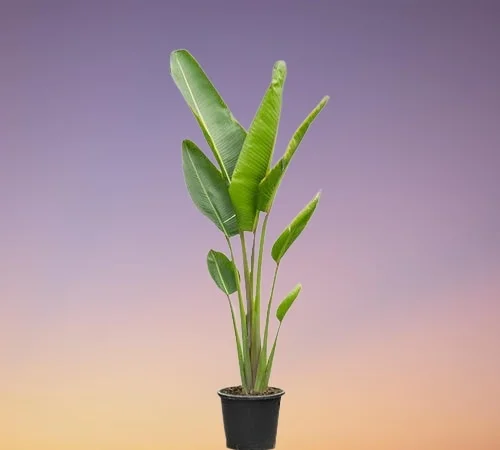
Ravenala madagascariensis Problems and Remedies
Traveller's Palm (Ravenala madagascariensis) problems include brown leaf tips and edges, yellow leaves, brown leaves, leaf spots and marks, pests and diseases among others. Read on for more on these problems and how to fix them.
Pests
The common pests in Traveller's Palm are spider mites, mealy bugs and scales. Spray the plant with an insecticidal soap or neem oil as indicated by the manufacturers.
Diseases
Traveller's Palm is prone to root-rot which is promoted by soggy soil brought about by poor drainage of the soil. Confirm that the pot has a drainage hole and that the soil is well-drained to prevent it from getting soggy. Decrease watering during the cold season to maintain the soil slightly moist as growth is minimal at this time.
Yellow leaves
There are two possible causes of yellow leaves in Traveller's Palm. One possible cause is soggy soil (too wet soil) due to poor drainage. Make sure that the pot has a drainage hole and the soil is free-draining soil to prevent the soil from getting soggy.
In addition, reduce watering during the cold season to maintain the soil slightly moist as growth is reduced at this time thus the plant does not require much water.
The second possible cause of yellow leaves in Traveller's Tree is underfeeding. Feed the plant with a nitrogen-rich, water-soluble fertilizer monthly during the growing season. Withhold fertilizer in the cold season as growth is reduced at this time and excess fertilizer can lead to brown leaves. Learn how to feed houseplants.
Brown leaves
The three most common causes of brown leaves in Traveller's Palm include soggy soil. Ascertain that the pot has a drainage hole and the soil is free-draining soil to prevent it from getting soggy.
The second possible cause of brown leaves in Traveller's Tree is overwatering. Water the plant deeply during the growing season and keep the soil moist while allowing the top 1-2 inches of soil to dry out between waterings.
During the cold season reduce watering to maintain the soil slightly moist as growth is minimal at this time, therefore, the plant requires very little water. Learn more on how to water houseplants the correct way.
The third possible cause of brown leaves in Traveller's Palm is overfeeding. Fertilizer the plant with a nitrogen-rich, water-soluble fertilizer monthly during the growing season. Do not feed in the cold season as growth is reduced at this time thus the plant does not require much feeding.
Brown, crispy leaf tips and edges
Brown and crispy leaf tips in Traveller's Palm are caused by too dry air (low humidity) as it thrives in warm, humid conditions. To increase humidity, set the pot on a wet pebble tray or use a cool mist humidifier.
Brown leaf spots
Brown leaf spots in Traveller's Palm are sun scorch marks caused by exposure of the plant to direct hot sunlight before acclimating it. Gradually acclimate the plant before exposing it to the hot direct sunshine outside. Move it to a slightly brighter spot every so often until it can withstand direct sunlight.
Brown speckled leaf markings
Brown speckled leaf markings in Traveller's Palm are caused by accumulation of salts in the soil from the water used or from overfertilizing. The plant is sensitive to excess salts in the soil.
To get rid of these accumulated salts, flush (leach) them out occasionally by running for a few minutes a steady stream of water through the soil until it comes out through the drainage holes. Repeat the process several times.
Conclusion
Traveller’s Palm (Ravenala madagascariensis) is a stunning, tropical houseplant that adds elegance and height to any space. Whether grown indoors or outdoors, it thrives with some sunlight, consistent watering, and occasional pruning. By following these care and propagation tips, you can enjoy a healthy and thriving Traveller’s Palm.
Frequently Asked Questions
1. How much sunlight does Traveller’s Palm need?
Traveller’s Palm thrives in full sun to bright, indirect light—ideally 6–8 hours per day.
2. How often should I water Traveller’s Palm?
Do not water on schedule. Water Traveller’s Palm when the top 2–3 inches of soil are dry. Avoid overwatering as it can cause yellowing and root-rot.
3. Can Traveller’s Palm grow indoors?
Yes. Traveller’s Palm can grow indoors if placed in a bright, warm spot with high humidity.
4. How fast does Traveller’s Palm grow?
Traveller’s Palm is a fast-growing plant, reaching 10 feet in just a few years under ideal conditions.
5. Why are my Traveller’s Palm leaves turning yellow?
This may be due to overwatering, poor drainage, or nutrient deficiencies.
6. Can I propagate Traveller’s Palm from cuttings?
No, Traveller’s Palm can only be propagated through division or seeds.
7. Is Traveller’s Palm toxic to pets?
No, Traveller’s Palm is non-toxic to cats and dogs.
You liked it? Share on social media.
Related Content
Amazon Associates Disclosure
Homeplantsguide.com is a participant in the Amazon Services LLC Associates Program, an affiliate advertising program designed to provide a means for sites to earn advertising fees by advertising and linking to amazon.com.



